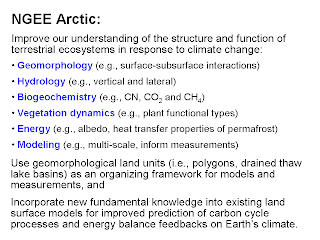It has been a great 10 days spent first at the NASA-sponsored ABoVE workshop, and then in Barrow for field research. I am confident that we have both a strong team and a great set of collaborators.
This week in Barrow, the NGEE Arctic accomplished many things thanks to the efforts of those from our vegetation dynamics and biogeochemistry teams. We had established scientists, post-docs and students working together to conduct measurements of plant community composition; analyses of plant gas exchange; root depth and distribution surveys; leaf area assessments; soil CO2 and CH4 determinations; and more. We were able to lay out trail mat so that we have a good start on the infrastructure required to support the science goals of the project. And, thanks to Mark Ivey, we have lab space in the BARC building and, as a result, we can develop more sophisticated techniques with which to tackle the complex and interconnected questions of the project. This will all be required if we are to model the dynamic evolution of the Arctic landscape for inclusion into Earth System Models.
While our week was a busy one, we did take time today to participate in one of the Nalukataq's held in Barrow during June. Two whaling crews, Yugu and Savik, hosted a village-wide festival to celebrate their respective successes during the Spring whaling season.
These events are a time when the crews and their families can be recognized for their hard work and, more importantly, when the crews can share a portion of the harvest with the local community. Members of the Yugu and Savik crews served coffee, tea, soups, and meat dishes as families exchanged greetings and the children played. It was a very festive environment and the local natives were quick to include us in discussions and descriptions of the various events. I spoke with a former whaling captain and heard many stories about the importance of whaling to the Inupiat people.
Finally, I found the brightly colored clothing most impressive. The women, in particular had elaborate coats with intricate decorations from beads and various furs from the North Slope region. The kids especially seemed to enjoy the event, including the traditional blanket toss. Alistair, Margaret, Victoria, Melanie and I sampled several of the offerings; the tea and soup helped keep us warm as wind chill temperatures dipped into the thirties due to a strong wind.
The Nalukataq will last all day with various activities. Tonight there will be Eskimo dancing in the community center. Unfortunatel,y I will be departing Barrow in just a few hours so the celebration will have to wait until I return again in July. For now, it was a scientifically productive trip and personally enjoyable. The people who are working with me on the NGEE Arctic project are a pleasure to associate with, as are the people and culture of Barrow.




















































